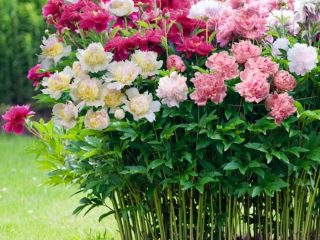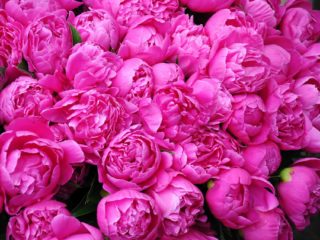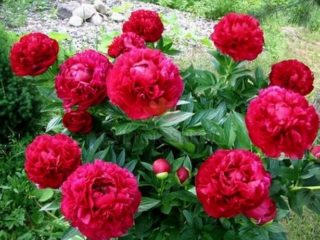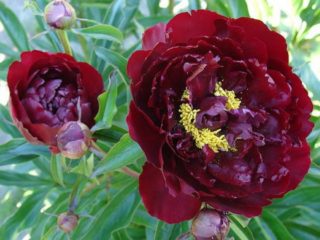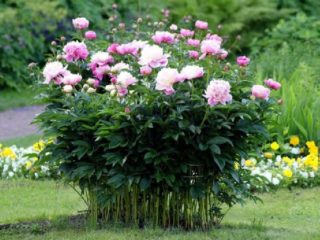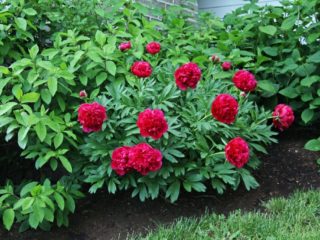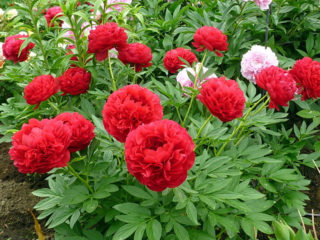Content
Peony Pink Hawaiian Coral is a piece of sunny Hawaiian Islands on the property. This flower is radiant, pleases with large inflorescences, and is relatively unpretentious in care. It was introduced in 1981 and has since been popular all over the world.
Description of peony Pink Hawaiian Coral
Peony belongs to the category of perennials and is classified as herbaceous. It has good frost resistance. Flowering duration is up to 3 weeks. Grows best in a sunny area. For the flowering period, the most favorable climate is cool and windless.
Herbaceous peony Pink Hawaii Coral reaches a meter in height. This is a robust plant with abundant glossy foliage in a rich green hue. The specimens bloom early, from the end of April; inflorescences are numerous. Peony foliage is leathery and shiny. Bushes are used in the design of flower beds and flower beds. Remarkable durability of cut inflorescences is observed.
Almost all regions are suitable for growing Pink Hawaiian Coral peonies, since the plant tolerates both hot summers and frosty winters. In very cold areas, the bush is additionally covered with a thick layer of peat for the winter. Frost resistance is good and increases over the years.
No special supports are required to grow the plant. Peony Pink Hawaiian Coral grows as a spreading bush, reaching a meter in height, but healthy stems are strong, quite thick and do not require additional support. Some gardeners tie the grown specimens so that they take up less space. This is necessary for landscape compositions and flower beds. Sometimes decorative supports are installed to prevent the plant from falling apart after precipitation.
Peony grows quickly. Over the years, the specimen acquires greater pomp and size. The inflorescences become larger. Replanting is required after 5-6 years of the bush living in one place.

Peony Pink Hawaiian Coral – “king of the garden”
Peony flowering features Pink Hawaii Coral
The plant belongs to the coral variety - the most popular peonies. Among these hybrids, Hawaiian Pink is the first to bloom. The shoots are strong, the inflorescences are single. The beauty is especially evident in the hot summer, when the petals seem to glow. Their texture resembles porcelain. Veins of bright pink color are clearly visible. The inflorescence is anemogoid.
Peony milky-flowered Pink Hawaiian Coral is a semi-double apricot decorative flower, the buds of which bloom into flowers with a diameter of more than 16 cm. As it grows, the inflorescence changes its shade to coral, and becomes cream closer to falling. In the center there are numerous stamens of a light, bright creamy color. The aroma is sweet, reminiscent of freshly cut grass.
Growing in the shade, the Lactiflora Pink Hawaiian Coral peony blooms in small, numerous inflorescences. If you plant a bush in a shaded part of the garden, you will have to thoroughly care for it, otherwise the plant will fade and become inconspicuous.
Application in design
Herbaceous peony Pink Hawaiian Coral is used in the design of gardens, greenhouses, flower beds, and front gardens. Asian designers consider it a symbol of good luck and prosperity. During flowering, the bush dominates the landscape. Plants are planted tightly so that the inflorescences merge into a single canvas.
To decorate a romantic garden or gazebo, peonies are planted at the entrance. The tenderness and sophistication of flowers will be emphasized by combination with warm-colored crops. Pink Hawaiian Coral is popular among landscape designers when creating monochrome compositions - it creates an active color spot. Stretch colors are achieved by composing a variety with different shades.

Flowers reach 20 cm in diameter
Peonies are good in group flower beds, where 3-5 perennial plants grow, blooming in turn. When designing paths, peony Pink Hawaiian Coral is combined with:
- primroses;
- astilbe;
- lilies;
- petunia;
- zinnia.
Pink Hawaiian Coral is chosen for rock gardens - the landscape becomes brighter.
Peony is good in combination with decorative onions, the heads of which contrast with the inflorescences and look even more delicate against their background. You can combine bushes with:
- cloves;
- heuchera in blood-red shades.
Dark green bushes will beautifully highlight the tenderness of peony buds. To place accents in the landscape, combine Pink Hawaiian Coral with:
- irises;
- lilies;
- bells.
Combinations with honeysuckle and poppy look interesting. You can combine dwarf and tall specimens, combine Pink Hawaiian Coral with juniper and tall trees.
Reproduction methods
Pink Hawaiian Coral is propagated by:
- division of roots;
- cuttings;
- pruning;
- stem cuttings;
- seeds;
- layering.
The most popular method is root division. Renewal buds form on underground shoots, from which new stems grow. Regularly appearing small roots are the main tool for Pink Hawaiian Coral peony to obtain useful compounds from the soil.
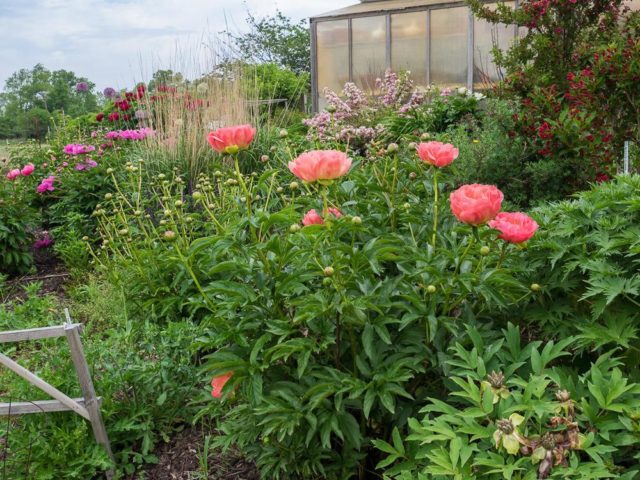
Pink Hawaiian Coral - an unpretentious flower
The roots are divided:
- at the end of April and beginning of May;
- at the end of August and beginning of September.
It is necessary to complete the work before the middle of the first autumn month so that the seedling takes root before frost.
The best material is a plant aged 3-4 years.
The work is as follows:
- Cut off the stems.
- Remove soil from the roots.
- The root is extracted.
- Remove the soil and wash the material to see the buds.
- Dry for several hours in a dark place.
- Adventitious roots are trimmed so that the length is up to 12 cm.
- The roots are divided with pruning shears so that each specimen contains 2 adventitious roots and 3 buds.
- Sick, rotten places are cleaned and disinfected with charcoal.
- The finished specimen is stored in the shade in the fresh air for 3 days. If you need to store it longer, dig it into moss or sand.
Landing rules
For Pink Hawaiian Coral, they dig a wide hole 1-2 weeks before planting so that the ground is saturated with oxygen. The plant is replanted at the beginning of the calendar autumn, no later than mid-September.It needs a slightly alkaline environment, so check the soil before planting. If the acidity is high, add ash and dolomite flour.
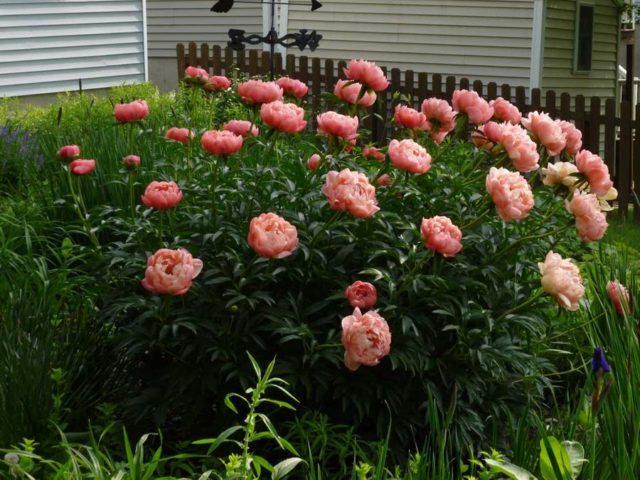
Pink Hawaiian Coral combines beautifully with various ornamental crops
Suitable place for the bush:
- on the sunny side;
- protected from the wind;
- 1.5-2 meters from large, permanent buildings.
To improve the quality of the soil, before planting, add a mixture of superphosphate, potassium sulfate, and ash. Spill the area with a solution of potassium permanganate.
When planting, a hill is poured at the bottom of the hole, a specimen is placed on it, the roots are straightened, and the voids are filled. Make sure that the thickness of the embankment above the upper bud is 2-3 cm. Mulch with hilled soil with compost and spruce branches.
Aftercare
Peony Pink Hawaiian Coral is unpretentious and does not require special conditions. The plant does not need regular watering and is valued by flower growers for its durability and undemanding nature. To make the view richer, you can shade it during the period of maximum flowering. This will extend the season and allow the petals to retain their bright coral hue longer.
Recommended watering periods:
- formation of buds (at this time, additional water will allow you to gain strength for a large number of large inflorescences);
- severe drought;
- the end of the first summer month and the first days of the next (renewal buds are being laid, the bush needs additional vital resources);
- flowering season (the beauty of the plant will last longer);
- second half of August (additional roots are formed, thanks to which the bush survives better and tolerates drought).
Illumination, air and soil heating have a stronger effect on the survival and beauty of Pink Hawaiian Coral than environmental humidity.
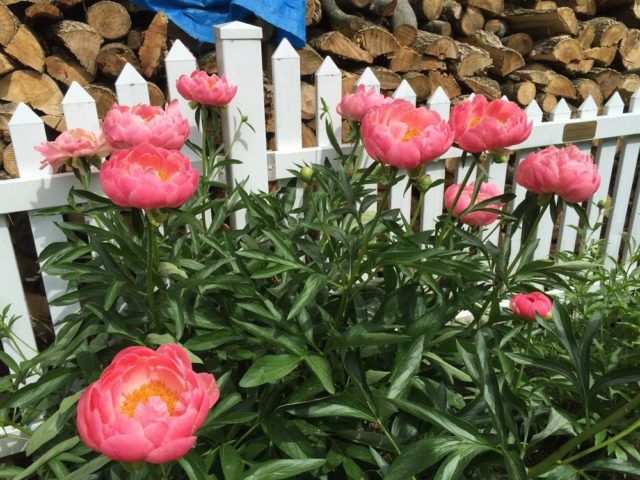
Pink Hawaiian Coral - decoration for any flower garden
The soil is fed three times every season:
- nitrogen mixtures in early spring;
- mineral compositions for flowering varieties during the period of bud setting;
- potassium and phosphorus after the buds open.
The quality and frequency of fertilizer application determine the appearance of the plant during the flowering season. Thanks to the first spring feeding, the greenery of the bush develops.
Peonies grow well in loose soil, but only the top centimeter of soil is cultivated next to the stems so as not to damage the buds. You can deep loosen the soil at a distance of 15 cm from the specimen. Thanks to the treatment, moisture is better retained in the ground, and weed seedlings disappear. For Pink Hawaiian Coral, the most harmful wild grasses are wheatgrass and thistle. It is advisable to loosen after watering or heavy rain.
Mulch in the spring with fresh horse manure. Rotted leaves and straw are not suitable - you can infect the plant with fungus. If the disease appears, do not use organic fertilizers, and remove the mulch.
Preparing for winter
The Pink Hawaiian Coral peony, planted near a tree, bush, or fence, overwinters better. If it is planted on a hill, it is additionally covered with mulch and a box, a layer of spruce branches. Plants growing in lowlands are harmed by stagnant, cold air. In order for the specimens to survive the cold, the roots are insulated with agril and burlap. They form a kind of hut from spruce branches and install it on top.
The time of pruning is determined by the climate of the region. In cold areas, the stems are harvested in mid-autumn, in warm regions - at the end. Cut off the top part so that the growth buds remain, the stumps do not exceed 4 cm.Cut organic matter is burned to avoid contamination.
The next step is mulching the soil with peat and humus. The thickness of the layer is 10-15 cm. In the north it is increased to 20 cm. Pink Hawaiian Coral peonies cannot be covered with cut stems.
In early spring, remove the cover, rake away the mulch, leaving only a thin layer to retain water in the soil and protect against the first weeds.

Peony inflorescences Pink Hawaiian Coral attract with a delicate coral shade
Pests and diseases
Once a year, Pink Hawaiian Coral is treated prophylactically with copper sulfate. Horticultural preparations can be used. Fungal diseases are the main threat. More often, the disease appears due to a lack of minerals due to early pruning and poor care. A regularly watered and well-fed bush will cope with the disease on its own.
More common:
- gray rot;
- rust;
- spotting.
When infested by pests, insecticides are used. Butterfly caterpillars may eat the buds. Sometimes the plant is harmed by bronze insects and ants. Nematode infection is possible. Caterpillars and beetles are collected by hand. Ant nests are sprayed with chemicals. “Kinmiks” and “Aktara” are effective. It is impossible to cure nematode infestation. All diseased areas are identified and burned.
Pink Hawaiian Coral peonies are threatened by viruses. More often, diseases appear with planting material. A healthy bush can become infected through a vector - aphids or other insects. Tobacco rattle virus is the most common. It appears as a marble pattern on the leaves. There are no cures for viral diseases. Having identified an infection, the bush is burned.
Conclusion
Peony Pink Hawaiian Coral is an unpretentious plant that delights with long-lasting (up to 3 weeks) flowering.The large, spreading bush loves the sun, rarely gets sick and retains its aesthetic appearance outside the flower season. Coral peony is valued by landscape designers and amateur flower growers; it is suitable for any climate and winters well. Such a plant can become the pearl of a flower garden.
Reviews of peony Pink Hawaiian Coral
